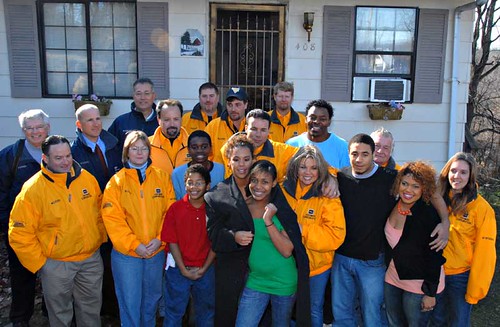
As your grassroots community takes the next step to becoming an official one, what challenges will you face?
Way back in 2008, microblogging and enterprise collaboration platform Yammer launched at TechCrunch50. A week later, I became member #1 of the Yammer network at my old firm, a 25,000 person consulting firm with offices all over the country. That started a three-year journey into the world of Enterprise 2.0, including growing our Yammer community from 1 to more than 7,000 when I left, consulting with dozens of organizations and government agencies, managing our official award-winning collaboration community, attending and speaking at Enterprise 2.0 Conferences, guest blogging over at AIIM, and writing a whole bunch of blog posts.
Over the years, “Enterprise 2.0” has evolved from fringe buzzword to an massive industry. The change agents who risked their jobs and reputations to start these networks a few years ago are being held up as innovators and leaders. Organizations that were loathe to spend any money on something as “soft” as collaboration are now spending millions to create robust internal communities on their Intranets.
But with this evolution comes a host of challenges as well. Official communities that began with large budgets are struggling to maintain their success with diminished resources. Passionate evangelists have left without anyone to take their place. Grassroots communities that sprouted up using freemium versions of these tools are trying to transition to officially sanctioned tools.
It’s these communities – the ones trying to migrate from free, unofficial, grassroots communities to official, integrated ones – that face some tough challenges now. There’s often an influx of new members, unfamiliar with the culture. Community mores and processes that worked with a smaller community don’t scale. Community leaders who emerged are replaced with community leaders who are named by leadership. Senior leadership pays closer attention to the conversations that occur, exposing some of the more frivolous discussions that may take place. And usability may suffer as the technology gets integrated into other systems and secured more than ever before.
As these communities make this transition and start anew, officially, I wanted to revisit six of my old Enterprise 2.0 posts to serve as reminders for those people responsible for these official migrations.
Dance with the one that brung ya. As organizations begin turning these grassroots communities into official ones, there’s a tendency to also name “official” leaders, community managers, and admins. Organizations may hire new people to take on these jobs, or they may move existing employees into these roles. While having a dedicated team and resources to manage the community is undoubtedly one of the benefits of formalizing the community, don’t forget about the people who have brought the community this far. These are the people who, without a formal policy, budget, or title have acted as referees, mentors, teachers, cheerleaders, and janitors for the community, all while also performing their “real” job. These people built and managed the community because they were passionate about it, not because they were tasked to do so. Involve them. Formalize their roles. Get their support. They’ve built up the community’s respect out of what they’ve done for it, not because they have a fancy title. They evolved from users to community managers to role models.
Don’t take the social out of “social media.” Social networking has always been and will continue to be a vital part of any organization, whether it happens online or on the softball field. People who work together don’t just talk about the work they do. Sure, that constitutes the bulk of the conversations, but people also talk about the game last night, share war stories about their kids, or complain about having to work late or the parking situation at the office. All those interactions build up over time, eventually creating trusted relationships among people who work closely together and often leading to more effective collaboration. Social networking platforms just allow us to extend those relationships to more people than ever before. The sooner managers realize that, the sooner they will recognize the benefits that such tools can provide.
Embrace the LOLCats. If you want to create a vibrant culture of collaboration, you need to be OK with pictures of LOLCats, posts about the NFL playoffs, arguments about Apple and Android, and criticism of company policies. What will follow is that these stupid, silly, foolish discussions will lead to relationships, questions, answers, and finally, very cool innovations, products, and solutions that will save you money, win you awards, and really and truly create a social business.
Don’t overthink the tech. Once an organization decides to go from freemium to premium and dedicate actual resources and budget to creating these internal communities, there’s a mad rush to start implementing all the cool features that weren’t available before. Integration with existing systems! Advanced administrative controls! Mass distribution of invitations! Before you get all worked up over all of this cool new tech, remember the three most basic rules – make it fast, make it accessible, and make it reliable. Get your newfound IT resources using the tool themselves so they can identify potential bugs, glitches, and feature requests first, before they negatively impact the rest of the community.
Temper the passions. As you move from an unofficial to official community, there will be a mashup of “stars” – the champions who became the unofficial community managers and those who will be designated official community managers in the new community. These stars and their passions bring both positives and negatives to the community. While these active champions will be responsible for a majority of the content, answering questions, posting content, editing pages, and creating topics, they can also skew the content to suit their own agenda and create a chilling effect on opposing viewpoints and topics. Left unchecked, they do have the potential to take over the community – its members, its content, and its discussion. The key is in channeling their energy and enthusiasm and focus it on helping grow the community as a whole, to include topics other than social media and technology.
Remember that this is about change management, not technology. Getting people to change the way they work takes time. To maintain the momentum, make sure you clearly communicate what problems the community is helping people solve. Help users see how the community will help them in their day-to-day lives. Get senior leaders to lead by example and engage with the community directly using the tools they’re already supporting in their emails and Powerpoints (even if it means occasionally being wrong). Provide meaningful, useful content every day, to every single user. Design the technology for the end-user, not for the IT department or for some senior leader. And finally, evolve the community based on the community’s feedback. Allow them to see how their feedback is shaping the future of the community.
As these organizations make the transition from unofficial, grassroots communities using free platforms to officially integrated communities on expensive, licensed platforms, some will succeed in scaling that sense of community to better the organization as a whole. Other organizations will see bureaucracy and old ways of doing things destroy the very communities they’re trying to scale. To avoid the latter, remember that this is still a community you’re building, not a new IT platform. Sure, it may sound great to talk about the thousands of users or the 90% adoption rate in conference presentations and blog posts, but that’s sacrificing long-term benefits for short-term gains. Stop chasing the numbers and stay focused on your business goals. Slow and steady wins the race.
If your organization is going through this process, what other challenges are you facing? What other strategies and tactics have been helpful in maintaining that sense of community?







 If your score was 16 or less, you don't have a community, you've got the man cave of a new dad. The place is filled with the latest technical toys but no one is around to use them. From the Xbox to the pool table to the fully-stocked bar, you had envisioned many nights partying with the boys watching football, but now that you have a new baby, the only thing all those toys are doing is collecting dust…just like your blogs, wiki pages, and profiles.
If your score was 16 or less, you don't have a community, you've got the man cave of a new dad. The place is filled with the latest technical toys but no one is around to use them. From the Xbox to the pool table to the fully-stocked bar, you had envisioned many nights partying with the boys watching football, but now that you have a new baby, the only thing all those toys are doing is collecting dust…just like your blogs, wiki pages, and profiles. If your score was between 17 – 24, your community most resembles China. You've got a lot of users (primarily because people are forced to create profiles), but very little sense of community. People talk with one another because they have to, and only when they need something. Conversations are guarded and transactional, and information is protected even more closely as trust between individuals is lacking. Non-work conversations are prohibited – none of that "social networking" stuff here!
If your score was between 17 – 24, your community most resembles China. You've got a lot of users (primarily because people are forced to create profiles), but very little sense of community. People talk with one another because they have to, and only when they need something. Conversations are guarded and transactional, and information is protected even more closely as trust between individuals is lacking. Non-work conversations are prohibited – none of that "social networking" stuff here! If your score was between 25 – 33, your community is most like a high school full of people still trying to figure out who they are, who their friends are, and how to communicate with each other. The adults are confused by the kids, the kids are kind of wary of the adults, but they all co-exist fairly peacefully. Diverse cliques form early and often – iPhone enthusiasts, social media geeks, developers – all with different goals and reasons for being. A few individuals stand out and connect these cliques across the entire school. Social conversation occurs, but is often forced, as people are trying to fit in and test the boundaries of what is allowed and what isn't.
If your score was between 25 – 33, your community is most like a high school full of people still trying to figure out who they are, who their friends are, and how to communicate with each other. The adults are confused by the kids, the kids are kind of wary of the adults, but they all co-exist fairly peacefully. Diverse cliques form early and often – iPhone enthusiasts, social media geeks, developers – all with different goals and reasons for being. A few individuals stand out and connect these cliques across the entire school. Social conversation occurs, but is often forced, as people are trying to fit in and test the boundaries of what is allowed and what isn't. If your score was between 34 – 44, congratulations! You've got the makings of honest-to-goodness social business community. People willingly share information freely across geographic, administrative and cultural lines not because they have to, but because they realize that by pitching in and helping, everyone benefits. Conversations run the gamut – some days, they're about
If your score was between 34 – 44, congratulations! You've got the makings of honest-to-goodness social business community. People willingly share information freely across geographic, administrative and cultural lines not because they have to, but because they realize that by pitching in and helping, everyone benefits. Conversations run the gamut – some days, they're about 
.jpg)
2 Comments